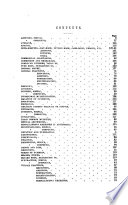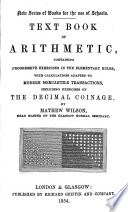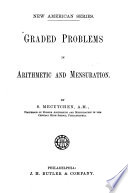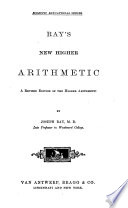 | Chambers W. and R., ltd - 1854 - 152 pages
...Multiply each quantity by its price; then add the quantities in one sum and the products in another, and divide the sum of the products by the sum of the quantities : the quotient is the average. Example. — I have bought two yards of cloth, at 10s. each... | |
 | Mathew Wilson - 1854 - 210 pages
...loss to either party. BULE : — Multiply each debt by the time which must elapse before it is due, and divide the sum of the products by the sum of the debts ; the quotient is the time required. EXAMPLE. Paid £480 as follows :— £60 in 40 days, £180... | |
 | Joseph Ray - Arithmetic - 1880 - 420 pages
...the terms of credit begin at the same date, we have the following rule : Rule. — Multiply each debt by its term of credit, and divide the sum of the products by the sum of the debts; the quotient will be the equated time. 326. If the account has credits as well as debits, it... | |
 | Samuel Mecutchen - Arithmetic - 1880 - 292 pages
...share of the gain or loss. EQUATION OF PAYMENTS. CASE I. MULTIPLY each debt by the number denoting its term of credit, and divide the sum of the products by the number denoting the sum of the debts ; the quotient will be the average term of credit. The average... | |
 | Joseph Ray - Arithmetic - 1880 - 420 pages
...the terms of credit begin at the same date, we have the following rule : Rule. — Multiply each debt by its term of credit, and divide the sum of the products by tfie sum of the debts; Hie quotient will be the equated time. 326. If the account has credits as well... | |
 | Samuel Mecutchen - Arithmetic - 1880 - 262 pages
...share of the gain or loss. EQUATION OF PAYMENTS. CASE I. MULTIPLY each debt by the number denoting its term of credit, and divide the sum of the products by the number denoting the sum of the debts ; the quotient will be the average term of credit. The average... | |
 | A. Melrose - 1881 - 314 pages
...mixture, when the quantities and rates of the simples are given. RULE. Multiply each quantity by its rate, and divide the sum of the products by the sum of the quantities. 1. Eight Ib. of sugar, at 4d. per Ib., were mixed with 5 Ib. at 5d., and 7 Ib. at 8d. ;... | |
 | H. Bryant - 1881 - 574 pages
...quality of 1 oz. is 20. RULE. Multiply the value or quality of each article by the number of articles, and divide the sum of the products by the sum of the articles. The quotient will te the average value or quality of the mixture. 3. A grocer mixed 15 Ib.... | |
 | James Bates Thomson - Arithmetic - 1882 - 450 pages
...to Oct. 10th, 1880 = Dec. 25th, 1880, the date of payment. Hence, the RULE. — Multiply each item, by its term of credit, and divide the sum of the products by the sum of the iterns Tlie quotient will be the average term of credit. Adding the average term of credit to the date... | |
 | Henry Bartlett Maglathlin - Arithmetic - 1882 - 398 pages
...55d. = May 26, the average time. 334. Rule to find the Average Time of Payment. Multiply each debt by its term of credit, and divide the sum of the products by the sum of the debts. The quotient will be the average term of credit. This added to the date from which the credits... | |
| |